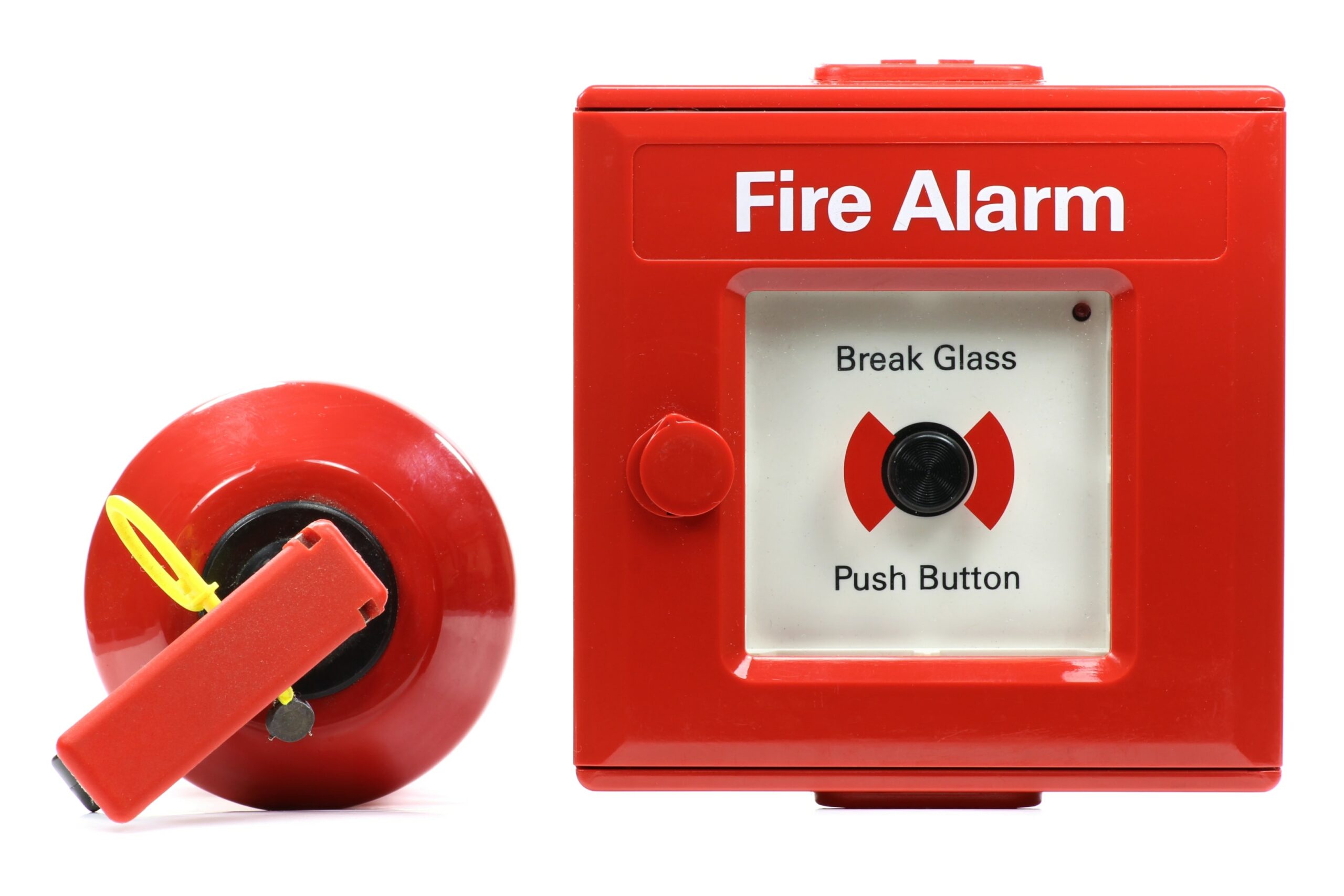Guide To Fire Alarm Categories And Grades
Fire alarms are one of the most important safety measures in any building. In the UK, fire alarm systems are classified into different categories and grades to ensure they provide the right level of protection depending on the type of property and its risks.
Table of Contents
This guide explains the fire alarm categories and grades UK standards so you can better understand how they work and what system may be suitable for your property.
Key Takeaways
- Fire alarm systems are graded from A to F, with Grade A being the most advanced, necessary for high-risk environments, and requiring compliance with BS5839 standards.
- Fire alarm categories are divided into L for life protection and P for property protection, with subcategories specifying detection strategies to suit various building needs.
- A professional fire risk assessment is essential to determine the appropriate fire alarm system, ensuring compliance with regulations and addressing specific safety requirements.
Understanding Fire Alarm System Grades

Fire alarm systems are categorised into grades ranging from A to F, with Grade A being the most advanced and Grade F being the most basic. This grading system is crucial for ensuring that the fire alarm installed is suitable for the specific environment and risk level. Each fire alarm category in BS5839 is tailored to address the specific risks and needs of different environments.
Grade A fire alarm systems must meet specific control system standards outlined in BS5839 Part 1 or Part 6. These systems are often required in high-risk areas in businesses, incorporating various detection technologies to ensure maximum safety. High-risk environments typically require systems graded from A to C to incorporate these advanced technologies and ensure comprehensive coverage, following the fire system specification.
Before installing a fire alarm system, it is crucial to carry out a fire risk assessment to identify the appropriate fire alarm category. This assessment guarantees that the system meets the building’s specific needs and complies with UK fire safety regulations. Understanding these grades enables you to make informed decisions that prioritise safety and compliance.
Overview of Fire Alarm Categories
Fire alarm categories indicate the level of protection provided by the system, as defined by the BS5839 standards. These categories are crucial for ensuring that the alarm system is suited to the specific risks and needs of the environment. There are eight fire alarm categories in total, each designed to address different fire alarm categories of protection needs.
The main types of fire alarm systems under BS5839 include:
- Manual systems: rely on manual call points to trigger the alarm.
- Automatic systems for life protection: use fire detectors to identify signs of fire and activate the alarm automatically.
- Automatic systems for property protection also use fire detectors for automatic activation. Fire detection systems play a crucial role in enhancing safety measures.
These systems are designed to provide early warning and facilitate the earliest warning response.
There are three main design categories for fire alarm systems. They are L for life protection, M for manual systems, and P for property protection. Each category has specific requirements and applications, ensuring that the system installed provides the appropriate level of protection for the building. Understanding these categories is essential for making informed decisions about fire safety.
Fire Alarm Categories (Non-Domestic Buildings – BS 5839-1)

In commercial and public buildings, fire alarm systems fall under two main categories: L for Life Protection and P for Property Protection. These categories are designed to address the specific risks and needs of non-domestic buildings, ensuring that the protection of the automated fire alarm system installed provides adequate protection.
The L and P categories each have several subcategories, providing different levels of protection based on the specific requirements of the building. These subcategories ensure that the installed fire alarm system meets the building’s specific needs and complies with fire safety regulations, including category p systems.
Life Protection (L Categories)
The L categories are designed to provide life protection by ensuring early detection and warning in the event of a fire. These categories range from L1 to L5, each offering different levels of protection.
Category L1 provides maximum life protection by:
- Installing automatic detectors throughout the entire building
- Ensuring that any sign of fire is detected early
- Allowing for a prompt response and evacuation with life protection automated fire.
Category L2 enhances life protection by placing detectors in escape routes and high-risk areas, ensuring quick detection in critical zones, including circulation areas, to protect life during safe evacuation, including fire exits and toxic fumes.
Category L3 provides standard life protection by installing detectors in escape routes and rooms connecting to these routes.
Category L4 offers modest life protection by installing detectors solely in escape routes.
Category L5 is a customised system tailored for specific risks, offering localised standard life protection.
Property Protection (P Categories)
The P categories are designed to protect property by ensuring early detection of fires, thereby minimising damage to assets and the building structure. These categories, P1 and P2, offer different levels of protection.
Category P1 maximises property protection by installing detectors throughout the commercial buildings. This ensures early fire detection, allowing for a prompt response to protect the building and its contents, including property protection and automated fire measures.
Category P2 provides minimum property protection by installing detectors only in high-risk areas. This ensures that critical areas are protected, reducing the risk of significant damage.
Fire Alarm Grades (Domestic Buildings – BS 5839-6)
In residential settings, fire alarms are grouped into grades that describe the type of equipment and power source used. These grades ensure that the fire alarm system installed is appropriate for the specific needs of the property, providing adequate protection for residents.
The grades range from A to F, with each grade offering different levels of protection and features. These grades ensure the fire alarm system meets the specific requirements of the property and complies with fire safety regulations.
Common Fire Alarm Grades in the UK
Grade A category fire alarm systems feature control panels, mains-powered detectors, alarm sounders, all powered by mains with a backup power supply, ensuring operation even during a power failure, including an integral standby supply. This includes essential fire detection and alarm components, a manual fire alarm system, an automated fire alarm system, and automatic fire detection.
Grade C systems are mains-powered alarms that are interconnected and have central control equipment, providing reliable protection.
Grade D1 systems are mains-powered alarms with tamper-proof, sealed battery backup, while Grade D2 systems have replaceable battery backup. These grades offer varying levels of reliability and maintenance requirements.
Grade F1 systems are battery-powered alarms with tamper-proof, sealed batteries, while Grade F2 systems have replaceable batteries. The required grade depends on the property type, such as private homes, rented accommodation, or houses in multiple occupation (HMOs).
How to Determine the Right System
Choosing the right fire alarm system depends on factors like:
- The building type (domestic or non-domestic)
- Occupant vulnerability
- Risk levels in different areas
- Legal and insurance requirements.
A professional fire risk assessment is the best way to establish the correct fire alarm system for any property. This assessment guarantees the system meets the building’s specific needs and complies with fire safety regulations, addressing potential fire risks.
At TF Installations, we provide expert advice, installation, and maintenance of fire alarm systems to ensure your property is protected and compliant. Our team of specialists is dedicated to helping you choose the right system for your specific needs.
Protect Your Property with TF Installations

Knowledge of fire alarm categories and grades is the first step towards compliance and safety. At TF Installations, our specialists provide tailored fire alarm solutions to meet your building’s exact needs. Whether protecting a commercial property, ground-floor offices, or roof spaces, our expertise ensures maximum protection.
Contact us today to arrange a consultation and ensure your fire safety is in expert hands. Our team is committed to providing the highest level of fire services and ensuring that your property is fully protected under the fire safety order, addressing potential fire hazards and offering fire safety services, especially in areas with a high fire risk.
Summary
Understanding fire alarm categories and grades is crucial for ensuring that your property is adequately protected. From the different grades of fire alarm systems to the specific categories for life and property protection, this guide has provided comprehensive insights to help you make informed decisions.
Taking the necessary steps to assess your fire safety needs and choosing the right system can save lives and protect property. Don’t leave it to chance—ensure your fire safety is in expert hands with TF Installations.
Frequently Asked Questions
What is the difference between fire alarm grades and categories?
The distinction between fire alarm grades and categories lies in that grades pertain to the type of equipment and power source utilised, whereas categories denote the level of protection offered by the system. Thus, understanding both aspects is crucial for ensuring adequate fire safety.
What is a fire risk assessment, and why is it important?
A fire risk assessment identifies and evaluates potential fire hazards in a building, ensuring compliance with safety standards and enhancing overall safety. This process is crucial for preventing fire incidents and protecting lives and property.
What are the main categories of fire alarm systems under BS5839?
The main categories of fire alarm systems under BS5839 are L (Life Protection), M (Manual Systems), and P (Property Protection). Each category serves a distinct purpose in ensuring safety and compliance.
How do I choose the right fire alarm system for my property?
To choose the right fire alarm system for your property, consider factors such as the building type, occupant needs, risk levels, and compliance with legal standards. Engaging in a professional fire risk assessment is advisable to ensure the most suitable system is selected.
Why should I choose TF Installations for my fire alarm needs?
Choosing TF Installations for your fire alarm needs is a prudent decision, as they provide expert advice, installation, and maintenance to ensure your property is both protected and compliant with safety regulations.










